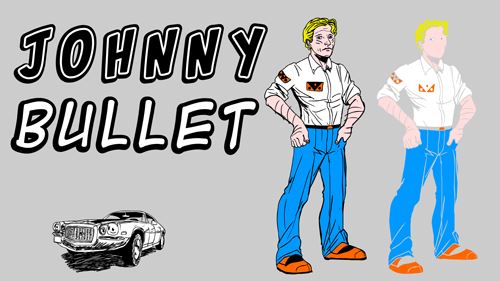Flatters – Unsung Heroes of Comics Production
By Hervé St-Louis
June 23, 2015 - 08:45
 |
I’ve been doing research on colouring for Johnny Bullet and also looking for a colourist. In one of my research, I stumbled onto comic flatting. Flatters are often junior assistants or pros who take on flatting freelancing jobs. Very few receive any mention in modern comics. It feels unfair that some of the people who do the most labour intensive in comics receive no recognition for making comics look good. Colourists take over the flatters’ work and select the final colours for areas depicted. They add the highlights, nuances, shades, and tones. Yet, the contribution of the flatter is very important to comics and how they look in the final page.
Coming from animation, the concept of flatting is not new. Animation colouring is a well-developed trade in animation production. Modern animation production software often have separate colouring modules that do much the same work that flatters do with Adobe Photoshop. This is the part that annoys me about the lack of recognition of the flatters who toil away in silence on some of the most popular comics in the world. Photoshop is a painful tool for flatting. Flatters’ work should be credited in comics.
Cartoon animation software is smarter than Photoshop. I’ve tested and researched them since 1999. Even back then, their colouring modules were geared for production. There were no painful selections of sections. Lines, in cartoon animation software are treated as separate objects. Just adding colours to the empty flat areas is sufficient. There is no need for complex layering work. Algorithms can even add automated shadows and highlights to flat coloured zones. There is a similar tool in Photoshop but the last time I checked, it didn’t separate the original pencil layer from the colour.
Naturally, my animation background made me decide to work on the comic with a vector program like Flash, as opposed to a bitmap program. Even in Flash, the flatting process is much quicker and less error prone. But the only reason that is so is because my inks are vector lines in Flash. I am not advocating vector over bitmap. I just find that the amount of work involved with bitmap flatting means some very patient and tough people work on something current Photoshop technology support painfully.
Why aren’t flatters credited as colourists for their work? Is this part of the ongoing deligitimization of the craft of comic book creators by larger publishers? Do publishers and self-publishers even know that their colourists are often hiring unaccredited cheap hands to help them turnaround a colouring project? Do they care that flatters remain unrecognized? Is this whole business of ignoring the contribution of flatters part of the ongoing push towards the bottom in the comic book industry where even established professional illustrators often receive less than $50 per pages?
I will probably work with a flatter to colour Johnny Bullet (provided that I can find one comfortable with vector flatting). This person will be credited as a colouring assistant. It is important to me. I am drawing a line here. The work flatters do may be considered brainless and artless, yet not everybody can start flatting comics overnight. Give the flatters some of their dignity back. Give them credits when they toil away on your comics.
Related Articles:
Johnny Bullet #1 Recoloured & Re-Lettered
Johnny Bullet n°1 recolorié et relettré
Candy Color Paradox: Volume 3 yaoi manga review
Johnny Bullet #00 in Colour
Simpson Comics Colossal Compendium Volume 7 comics review
Candy Color Paradox: Volume 1 yaoi manga review
SuBLime Manga Announces "Candy Color Paradox"
Johnny Bullet #1 in Colour
VIZ Media Announces "One Piece Color Walk Compendium"
VIZ Media Release "The Hello Kitty and Friends Coloring Book"
